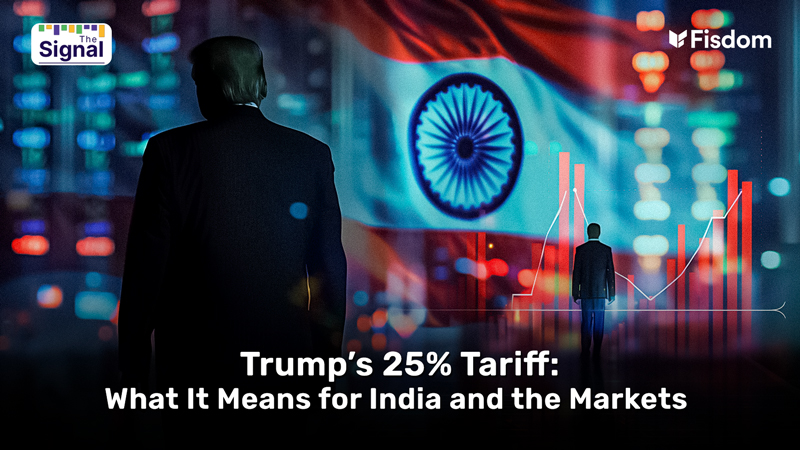
The Indian equity markets continued their losing streak last week, marking six consecutive weeks of declines for the benchmark indices — the Sensex and Nifty 50. Both indices slipped close to 1% during the week ended August 8, weighed down by escalating trade tensions with the United States.
The broader markets faced steeper losses, with the BSE Midcap index falling 1.3% and the Smallcap index retreating nearly 2%. This underperformance in mid- and small-cap counters reflected heightened investor caution, as the external environment turned more hostile.
A key driver of this weakness was the United States’ decision to sharply increase import duties on Indian goods. President Donald Trump announced that cumulative tariffs on Indian exports to the US have now reached 50%, doubling down on his earlier measures. This aggressive move has unsettled market sentiment, as investors weigh the potential economic fallout.
Tariffs Take Centre Stage
Trump’s decision to impose higher tariffs has not only raised concerns about India’s export competitiveness but also cast uncertainty over the trajectory of bilateral trade talks. The US President has indicated that negotiations with India will remain suspended until the tariff dispute sees some resolution.
Analysts warn that the current tariff structure could shave up to 1% off India’s GDP growth rate. While there is cautious optimism that talks may eventually lead to a reduction in duties — potentially in the 15–25% range — the path to such an outcome remains unclear. India’s tariff exposure is notably higher than that of its regional export rivals such as Bangladesh and Vietnam, and even China.
Adding another layer of complexity is the progress on US–China trade talks. Reports suggest that both sides are moving toward a deal ahead of the August 12 deadline, possibly settling on a temporary arrangement before President Trump’s scheduled meeting with Chinese President Xi Jinping later in the year. Any breakthrough here could re-channel foreign capital toward Chinese markets, diverting flows away from India.
Key Economic Data on the Radar
The coming week will be shortened by the Independence Day holiday on Friday, August 15, but it promises no shortage of market-moving developments. Among the most important will be inflation data from both India and the US.
For India, the CPI (Consumer Price Index) print will provide fresh insight into the trajectory of price pressures and the likely policy stance of the Reserve Bank of India. In the US, inflation readings will be watched closely for clues on whether the Federal Reserve can maintain its current policy approach or will need to adjust course.
Geopolitics Could Steal the Spotlight
Adding to the global risk calendar, US President Donald Trump is set to meet Russian President Vladimir Putin in Alaska on August 15. The meeting is aimed at discussing potential pathways to end the Russia–Ukraine conflict, which began with Russia’s invasion of Ukraine in February 2022. Kremlin adviser Yuri Ushakov has described the talks as a “challenging process,” but one in which both sides will participate “actively and energetically.” Any sign of progress could have far-reaching consequences for global commodity prices, currency movements, and broader market sentiment.
FPI Flows — Caution Amid Selective Buying
Foreign portfolio investors have been consistent sellers of Indian equities in recent weeks. In July alone, FPIs pulled ₹47,666.68 crore from the cash market segment. August has so far seen further outflows of ₹14,018.87 crore.
However, there was a glimmer of positivity on Friday, August 8, when FPIs turned net buyers, purchasing ₹1,932.81 crore worth of equities. While it’s too early to call this a trend reversal, sustained buying could lend much-needed support to the domestic market.
The interplay between foreign capital flows and external triggers like tariffs, earnings results, and global bond yields will be crucial. Last week, the US dollar index slipped nearly 1%, but benchmark 10-year US Treasury yields rose by 1.5%, ending a two-week decline. These shifts in the global macro backdrop will continue to influence FPI positioning.
Earnings Season in Full Swing
Back home, corporate earnings will also dictate sentiment. According to BSE data, over 2,000 companies are slated to announce their June quarter results in the coming week. Investors will be particularly focused on updates from Bajaj Consumer Care, Ashok Leyland, ONGC, IOC, Hindalco Industries, BPCL, and Hindustan Copper.
Given the current environment of global uncertainty and domestic headwinds, the earnings commentary from these companies will be scrutinized for signs of demand resilience, margin trends, and capital expenditure plans.
Outlook for the Week Ahead
With so many moving parts, market participants are bracing for continued volatility. Tariff developments remain the biggest single swing factor, particularly given the high degree of uncertainty surrounding US policy toward India. Inflation data from both India and the US will shape interest rate expectations, while the Trump–Putin meeting could bring unexpected geopolitical shifts.
Meanwhile, FPI flows and corporate earnings will serve as immediate barometers of investor confidence in Indian equities. For the benchmark indices, a break above the trading range that has persisted since June will likely require a clear, positive trigger — something that’s been in short supply of late.
Until then, traders and investors alike will be keeping one eye on the domestic earnings calendar and another on the global political and economic stage, ready to recalibrate positions as new developments unfold.
Market this week
| 04th Aug 2025 (Open) | 18th Aug 2025 (Close) | %Change | |
| Nifty 50 | ₹ 24,596 | ₹ 24,363 | -0.9% |
| Sensex | ₹ 80,766 | ₹ 79,858 | -1.1% |
Source: BSE and NSE
- Indian equities declined for the sixth straight week, marking the longest weekly losing streak in five years, pressured by renewed US tariff concerns.
- Investor sentiment was further dampened by mixed Q1 earnings, persistent FII outflows, a weaker rupee, and the RBI’s hawkish policy stance.
- Sector-wise, Nifty Pharma, Realty, FMCG, and Healthcare indices slipped around 2% each, while PSU Bank, Media, and Metal indices managed gains of 0.5–1.5%.
- FIIs remained net sellers for the sixth week in a row, offloading equities worth ₹10,652.47 crore, although they turned buyers on the week’s final trading day.
- DIIs continued their buying streak for the 16th consecutive week, adding equities worth ₹33,608.66 crore.
- The Indian rupee depreciated for the fifth week in a row, ending at 87.66 per US dollar on August 8, down 14 paise from the previous week’s close, after touching a low of 87.89 and a high of 86.24 during the week.
Weekly Leaderboard
| NSE Top Gainers | NSE Top Losers | ||||
| Stock | Change (%) | Stock | Change (%) | ||
| Hero MotoCorp | ▲ | 6.7% | Adani Enterprises | ▼ | -7.4% |
| Titan Company | ▲ | 4.4% | Apollo Hospitals | ▼ | -3.6% |
| TATA Steel | ▲ | 3.2% | Infosys | ▼ | -3.2% |
| Tech Mahindra | ▲ | 2.9% | Sun Pharma | ▼ | -2.6% |
| HDFC Life Insurance | ▲ | 2.7% | Jio Financial Services | ▼ | -2.5% |
Source: BSE
Stocks that made the news this week:
Defence stocks retreated last week as weak earnings from key players, profit booking, and the absence of fresh triggers weighed on sentiment. This pullback came after a stellar run in recent months, fuelled by India’s ‘Operation Sindoor’ in May, escalating global conflicts, and NATO’s decision to raise defence spending targets, which had pushed the Nifty India Defence index up 42 percent since 2024 to a record high in June.
Coforge slumped for the third time in four sessions, erasing over 10 percent in four days, after major client Sabre Corp crashed 35 percent on the Nasdaq following disappointing quarterly results. Sabre cut its full-year revenue growth outlook to flat-to-low single digits from high single digits and lowered EBITDA guidance to $530–570 million from $630 million earlier, with slower Air Distribution Volumes growth projections adding further pressure.
Tata Motors fell over a percent to ₹639, extending its losing streak to a third day, as caution prevailed ahead of its Q1 earnings release. Street estimates point to an 8.7 percent year-on-year drop in revenue to ₹98,600 crore and a steep 33.5 percent fall in net profit to ₹3,672 crore, driven by expected weakness in sales and margins.














